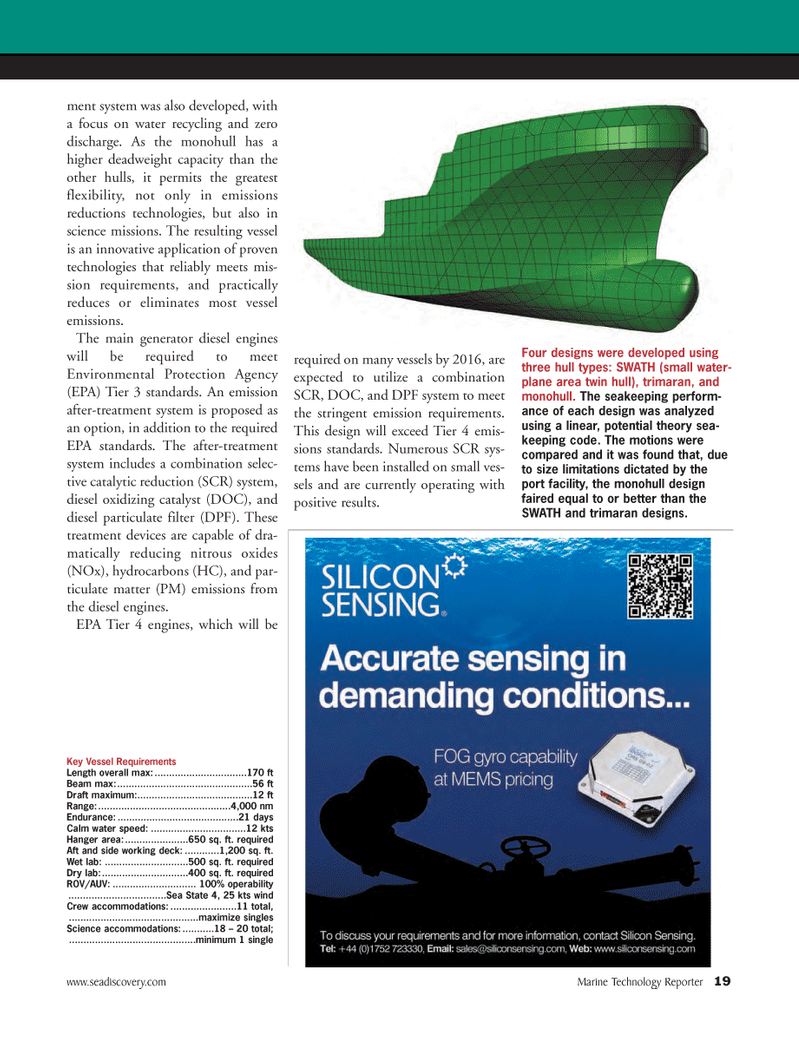
Page 19: of Marine Technology Magazine (November 2011)
FreshWater Monitoring and Sensors
Read this page in Pdf, Flash or Html5 edition of November 2011 Marine Technology Magazine
ment system was also developed, with a focus on water recycling and zero discharge. As the monohull has ahigher deadweight capacity than the other hulls, it permits the greatest flexibility, not only in emissions reductions technologies, but also in science missions. The resulting vessel is an innovative application of proven technologies that reliably meets mis- sion requirements, and practically reduces or eliminates most vessel emissions.The main generator diesel engineswill be required to meet Environmental Protection Agency (EPA) Tier 3 standards. An emission after-treatment system is proposed as an option, in addition to the required EPA standards. The after-treatment system includes a combination selec-tive catalytic reduction (SCR) system, diesel oxidizing catalyst (DOC), and diesel particulate filter (DPF). These treatment devices are capable of dra- matically reducing nitrous oxides (NOx), hydrocarbons (HC), and par- ticulate matter (PM) emissions from the diesel engines.EPA Tier 4 engines, which will be required on many vessels by 2016, are expected to utilize a combination SCR, DOC, and DPF system to meetthe stringent emission requirements. This design will exceed Tier 4 emis- sions standards. Numerous SCR sys- tems have been installed on small ves- sels and are currently operating with positive results. Key Vessel Requirements Length overall max:................................170 ft Beam max:...............................................56 ftDraft maximum:........................................12 ftRange:..............................................4,000 nm Endurance:..........................................21 days Calm water speed:.................................12 kts Hanger area:......................650 sq. ft. required Aft and side working deck:............1,200 sq. ft. Wet lab:.............................500 sq. ft. required Dry lab:..............................400 sq. ft. required ROV/AUV:.............................100% operability ..................................Sea State 4, 25 kts windCrew accommodations:.......................11 total, .............................................maximize singlesScience accommodations:...........18 ? 20 total; ............................................minimum 1 singleFour designs were developed using three hull types: SWATH (small water- plane area twin hull), trimaran, and monohull.The seakeeping perform- ance of each design was analyzedusing a linear, potential theory sea-keeping code. The motions were compared and it was found that, due to size limitations dictated by theport facility, the monohull design faired equal to or better than the SWATH and trimaran designs. www.seadiscovery.com Marine Technology Reporter 19MTR#9 (18-33):MTR Layouts 11/28/2011 10:22 AM Page 19

 18
18

 20
20
